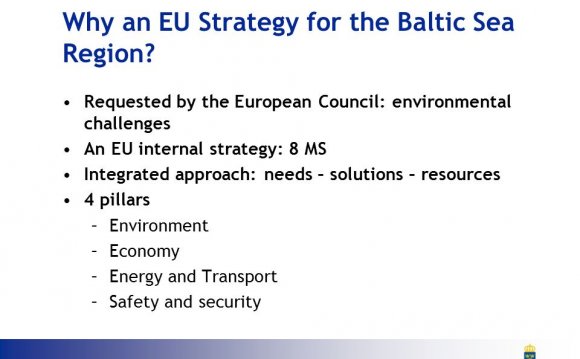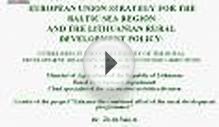
The communication aims to propose an overall EU Strategy for the Baltic Sea Region (EUSBSR). This strategy looks to strengthen cooperation in this region so as to respond to the common challenges it faces and to promote ecologically-responsible economic development.
ACT
Communication from the Commission to the European Parliament, the Council, the European Economic and Social Committee and the Committee of the Regions concerning the European Union Strategy for the Baltic Sea Region (COM(2009) 248 final of 10 June 2009).
SUMMARY
WHAT IS THE AIM OF THIS COMMUNICATION?
KEY ELEMENTS
The strategy covers the European Union (EU) countries that border the Baltic Sea (Denmark, Estonia, Finland, Germany, Latvia, Lithuania, Poland and Sweden).
It is focused on three main objectives.
|
1. |
Save the sea: this objective concerns the Baltic Sea’s vulnerability to eutrophication (when there is an excess of nutrients in the water that creates an explosive growth of algae), pollution and over-fishing, for example, which place particularly high demands on cooperation within the region. This objective is also about achieving a good environmental status and biological diversity in the sea and making the Baltic Sea region a model region for clean and safe shipping. |
|
2. |
Connect the region by making the energy and transport systems of the countries in the region more interconnected, including in the remotest areas (northern Finland and Sweden). It might also be about concrete partnerships for fighting cross-border crime, such as human trafficking, etc. |
|
3. |
Increase prosperity by removing obstacles to the domestic market of the Baltic region, developing the common economic, cultural and touristic basics and encouraging innovation with the joint Baltic Sea research and development programme (BONUS). |
Macro-regional approach
These three objectives are divided into a range of actions implemented in policy areas taking the form of macro-regional actions. These actions help in responding to the common challenges in an area (enable a sustainable environment, enhance the region’s prosperity, increase accessibility and attractiveness and ensure its safety and security).
The actions implemented therefore have an impact on the entire area beyond the borders of the countries covered.
They can take the form of:
|
flagships actions designed to promote clean shipping methods or support SME growth, for example; |
|
joint initiatives involving several countries in an area to encourage networking and interconnectivity. |
Methods of intervention
The European Structural Funds and Investment Fund (ESI) for 2014-20 are key funding sources of the strategy. However, the actions and projects under the strategy and its action plan can be funded by many other financial sources (Horizon 2020, BONUS programme, the LIFE programme, education and culture programmes, the Interreg Baltic Sea region programme, etc.), as well as national, regional and private sources.
Actions and projects in the transport, energy and information and communication technology (ICT) sectors may also become eligible for funding by the Connecting Europe Facility (CEF). In addition, some major projects could benefit from the support of international financial institutions, such as the European Investment Bank and the Nordic Investment Bank.
Governance
Given its macro-regional scope, implementing the strategy calls for the involvement of all stakeholders: civil society actors and regional, national and EU authorities.
BACKGROUND
An initial strategy had been proposed by the Commission in 2009 and adapted in 2012 to address the common macro-regional challenges faced by the Baltic area. A revised action plan of the strategy was presented in June 2015.
RELATED ACTS
Decision No 862/2010/EU of the European Parliament and of the Council of 22 September 2010 on the participation of the Union in a joint Baltic Sea research and development programme (BONUS) undertaken by several Member States (OJ L 256 of 30.9.2010, pp. 1-14).
Report from the Commission to the European Parliament, the Council, the European Economic and Social Committee and the Committee of the Regions on the implementation of the EU Strategy for the Baltic Sea Region (EUSBSR) (COM(2011) 381 final of 22 June 2011).
Communication from the Commission to the European Parliament, the Council, the European Economic and Social Committee and the Committee of the Regions concerning the European Union Strategy for the Baltic Sea Region (COM(2012) 128 final of 23 March 2012).
Report from the Commission to the European Parliament, the Council, the European Economic and Social Committee and the Committee of the Regions concerning the added value of macro-regional strategies (COM(2013) 468 final of 27 June 2013)
RELATED VIDEO




 Euroregion Baltic (ERB) is an institutionalised form of cross-border cooperation in the south-east of the Baltic Sea Region, consisting of eight regions of Denmark, Lithuania, Poland, Russia and Sweden. The ERB was the first Euroregion to have formally included a...
Euroregion Baltic (ERB) is an institutionalised form of cross-border cooperation in the south-east of the Baltic Sea Region, consisting of eight regions of Denmark, Lithuania, Poland, Russia and Sweden. The ERB was the first Euroregion to have formally included a...








